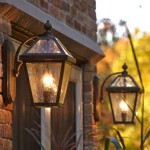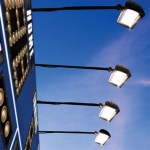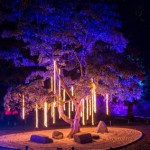Outdoor String Light Set Up: A Comprehensive Guide
Outdoor string lights offer an aesthetic and functional solution for illuminating patios, gardens, decks, and other exterior spaces. Their versatility and relatively simple installation make them a popular choice for creating ambiance and extending the usability of outdoor areas into the evening. However, a successful outdoor string light setup requires careful planning, selection of appropriate materials, and adherence to safety guidelines. This guide provides a comprehensive overview of the key considerations involved in installing outdoor string lights.
Planning the Layout and Power Source
The first step in any outdoor string light project is to determine the desired layout and identify a suitable power source. This initial planning phase will significantly influence the choice of lights, the necessary hardware, and the overall safety and aesthetics of the installation.
Consider the area to be illuminated. Measure the distance between potential anchor points such as trees, posts, fences, or the building's exterior. This measurement will determine the length of string lights required. It is advisable to slightly overestimate the required length to allow for slack and variations due to the natural contours of the space. It is also crucial to consider the desired effect. Do you want a straight line of lights across the patio, a draped effect between posts, or a whimsical zig-zag pattern across the garden? Sketching out the layout beforehand can help visualize the final result and identify any potential challenges.
Next, identify a reliable power source. Outdoor string lights typically operate on either standard 120V AC power or low-voltage DC power. Standard voltage lights are plugged directly into an outdoor-rated electrical outlet. If an outlet is not readily available, an extension cord rated for outdoor use is necessary. Always prioritize safety by using a Ground Fault Circuit Interrupter (GFCI) outlet to protect against electrical shock. Low-voltage lights, on the other hand, use a transformer to convert standard AC power to a safer DC voltage. These lights are often preferred for larger installations or areas where running extension cords poses a tripping hazard. Solar-powered string lights are another option, eliminating the need for electrical outlets altogether, but their brightness and duration often depend on sunlight availability.
When selecting the power source and planning the layout, consider the placement of electrical outlets and extension cords. Ensure that extension cords are not subjected to excessive strain or abrasion, and that they are properly rated for outdoor use. Avoid running cords across walkways or areas where they could be a tripping hazard. If burying cords is necessary, use direct burial-rated cable housed within a conduit for protection. Consider the overall aesthetic appeal of the power source. Hide extension cords behind plants or landscaping, or use decorative cord covers to minimize their visibility.
Selecting the Right String Lights
The market offers a wide variety of outdoor string lights, each with its own characteristics and suitability for different applications. Selecting the right lights involves considering factors such as bulb type, material, weather resistance, and overall aesthetic.
Bulb type is a primary consideration. Incandescent bulbs, while producing a warm and inviting glow, are less energy-efficient and have a shorter lifespan than LED bulbs. LED string lights are the more common choice due to their low energy consumption, long lifespan, and cool operating temperature. They are available in a variety of color temperatures, from warm white to cool white, allowing for customization of the ambiance. Consider the bulb shape and size as well. Globe lights, Edison bulbs, and miniature Christmas lights all offer different aesthetic appeals. The choice of bulb should complement the overall style of the outdoor space.
The material of the string lights is also important for durability and weather resistance. Look for string lights with heavy-duty wiring and weatherproof sockets. The wire gauge should be appropriate for the total wattage of the lights. A thicker gauge wire can handle a higher current load, reducing the risk of overheating. The sockets should be made of durable plastic or rubber that can withstand exposure to sunlight, rain, and snow. Confirm the IP rating of the lights. The IP (Ingress Protection) rating indicates the level of protection against dust and water ingress. A higher IP rating indicates greater protection. For example, an IP65 rating indicates protection against dust and low-pressure water jets, making it suitable for most outdoor applications.
Beyond functionality, consider the overall aesthetic of the string lights. Choose lights that complement the style of the outdoor space. For a rustic or vintage look, consider Edison bulb string lights with a copper or black finish. For a modern look, consider globe lights with a clean, minimalist design. The color of the wiring and sockets can also influence the overall aesthetic. Black wiring tends to blend in more easily with dark backgrounds, while white or clear wiring can provide a brighter, more visible look.
Installation Techniques and Safety Considerations
Proper installation is crucial for both the safety and longevity of outdoor string lights. Securely anchoring the lights, protecting the wiring, and adhering to electrical safety guidelines are essential for a successful installation.
Begin by installing anchor points for the string lights. These anchor points can be existing structures such as trees, posts, or fences, or they can be purpose-built supports. When using trees as anchor points, be mindful of the tree's growth. Avoid wrapping the string lights directly around branches, as this can restrict growth and damage the tree. Instead, use tree-friendly straps or rope to create a secure anchor point. For posts or fences, use hooks, eyelet screws, or zip ties to attach the string lights. Ensure that the anchor points are strong enough to support the weight of the lights, especially in windy conditions. For larger installations or areas with no existing supports, consider installing dedicated posts. These posts should be sturdy and properly anchored in the ground. Use concrete to set the posts in place for added stability.
When hanging the string lights, use guide wires to provide additional support. Guide wires are especially important for long spans or areas prone to strong winds. These wires should be made of steel or another durable material and should be tensioned properly to prevent sagging. Attach the string lights to the guide wires using zip ties, S-hooks, or other fasteners. Space the fasteners evenly along the length of the string lights to distribute the weight and prevent stress on individual bulbs or sockets.
Electrical safety is paramount during installation. Always disconnect the power source before working with electrical wiring. Use outdoor-rated extension cords and plugs with GFCI protection. Ensure that all connections are properly sealed and protected from moisture. Avoid overloading circuits by calculating the total wattage of the lights and ensuring that it does not exceed the capacity of the circuit. Inspect the string lights regularly for signs of damage, such as frayed wires or cracked sockets. Replace any damaged lights immediately. If using solar-powered string lights, position the solar panel in a location that receives direct sunlight for several hours each day. Clean the solar panel regularly to remove dirt and debris, which can reduce its efficiency.
Furthermore, consider local building codes and regulations. Some municipalities may have restrictions on the installation of outdoor lighting, particularly in residential areas. Check with the local building department to ensure compliance with all applicable codes. Consider the impact of the lighting on neighbors. Avoid directing bright lights towards adjacent properties, as this can cause light pollution and disturb their privacy. Use dimmer switches or motion sensors to control the brightness and duration of the lights. By following these installation techniques and safety considerations, outdoor string lights can provide years of enjoyment and enhance the beauty of outdoor spaces.

28 Backyard Lighting Ideas How To Hang Outdoor String Lights

How To Hang Patio Lights

How To Hang String Lights Outdoors

Diy Outdoor Patio String Lights Landscape Lighting Guru

How To Hang String Lights Outdoors

How To Hang Patio Lights

Diy Patio Arbor Using String Lights The Honeycomb Home

How To Hang Outdoor String Lights Step By Guide

Outdoor String Light Ideas Oclights

13 Backyard String Light Ideas That Are Stunning Bob Vila







